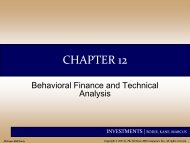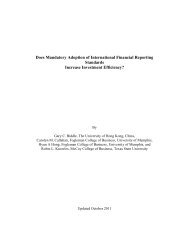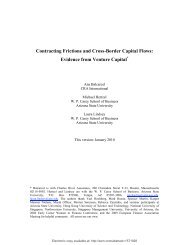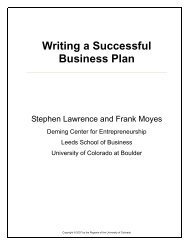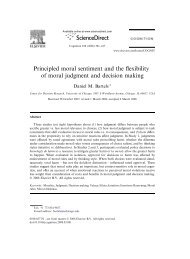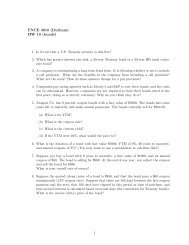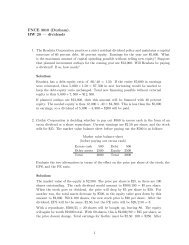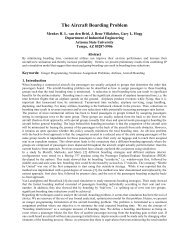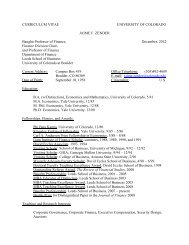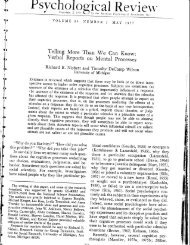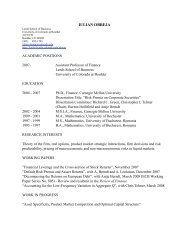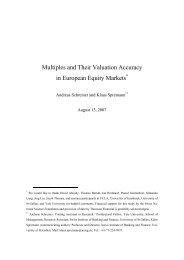8. Capital budgeting (part 3)
8. Capital budgeting (part 3)
8. Capital budgeting (part 3)
Create successful ePaper yourself
Turn your PDF publications into a flip-book with our unique Google optimized e-Paper software.
1<strong>8.</strong> <strong>Capital</strong> <strong>budgeting</strong> (<strong>part</strong> 3)• In the previous chapters, we have learned to forecast cash flows and looked at differentways of evaluating a project based on those cash flows.• The problem is that cash flow projections are subject to a great deal of uncertainty.• In this chapter, we look at some ways to address this issue. Some of the questions we willwant to examine include:– What is the range of possible outcomes?– How sensitive are our conclusions to changes in the underlying assumptions?– How can we evaluate down-side risk and up-side potential?– Are there any ways to minimize risk?—
Overview — continued2We will examine several tools for thinking about uncertainty:• scenario analysis• sensitivity analysis• Monte Carlo simulation• break-even analysis—• real options
Scenario analysis3• Construct several scenarios based on different sets of underlying assumptions.• A common framework is to look at– worst case– base case– best case• The “base case” represents our belief as to the most likely outcome.• The terms “best” and “worst” should not be taken too literally. Optimistic and pessimisticmight be better.• Other kinds of scenarios might be of interest, e.g.– high energy prices– business cycle– election results– interest rates– geopolitical environment– etc...—
Example4• Suppose we are considering bringing out a new line of expresso machines. Our market researchsuggests the following data:worst case base case best case----------------------------------Unit sales 5500 6000 6500Unit price 75 80 85Variable costs per unit 62 60 58Fixed costs per year 55,000 50,000 45,000• Suppose that the project has– initial costs of $200,000– a five-year life– no salvage value– No NWC needs• Evaluate the project using– Straight-line depreciation– 34% tax rate– 12% discount rate• What is the range of possible outcomes?—
Example — continued5• First, compute the cash flows (the easiest way is using the tax-shield approach):worst case base case best caseSales 412500 480000 552500Costs 396000 410000 422000Depr 40000 40000 40000-----------------------------------------------------OCF 24490 59800 99730• Using these cash flows and an initial cost of $200,000, compute NPV and IRR:worst case base case best caseNPV (R=12) -111,719.03 15,565.62 159,504.33IRR -14.40 15.10 40.88• What do you think of this investment? (Which is more useful, NPV or IRR?)—
Discussion6It is difficult to say much about this example without additional information. But issues onemight think about if doing this analysis include:• How likely is each scenario?• Is the expected return sufficient to compensate the risk? How might one go about assessingthis?• Are there other relevant scenarios? (energy prices, labor problems...)• Can the firm survive the worst case?• Maybe the firm is distressed and will not survive unless it hits a home run ...—• What do the managerial incentives look like (options, bonuses, termination, ...)?
Example8Returning to the previous example, let’s do a sensitivity analysis on the sales forecast (all othervariables remain constant).• Assumptions:worst case base case best caseUnit sales 5500 6000 6500Unit price 80 80 80VC 60 60 60FC 50,000 50,000 50,000• Suppose that the project has– initial costs of $200,000– a five-year life– no salvage value• Evaluate the project using– Straight-line depreciation– 34% tax rate– 12% discount rate—
Example — continued9• First, compute the cash flows:worst case base case best caseSales 440000 480000 520000Costs 380000 410000 440000Depr 40000 40000 40000-------------------------------------------OCF 53200 59800 66400• Using these cash flows and an initial cost of $200,000, compute NPV and IRR:worst case base case best caseNPV (R=12) -8,225.91 15,565.62 39,357.14IRR 10.33 15.10 19.68—
Figure: Sensitivity analysis10Note financial break-even point (we will discuss this in more detail later).The slope of this line tells us the sensitivity of NPV to change in sales:—∆ NPV 39357.14 − 15565.62= = 47.58∆ Sales 6500 − 6000
Monte Carlo simulation analysis11• A more sophisticated way to proceed would be to assign probability distributions to therelevant input variables and then simulate (using a computer) the project outcomesacross many different realizations of the input variables.• The result would be a complete probability distribution over possible outcomes. This wouldgive us a good idea of the range and likelihood of possible outcomes.• It is not difficult to run the actual simulations. The hard thing is to come up with realisticdistributions for the inputs.See www.vertex42.com/ExcelArticles/mc—
Break-even analysis12Break-even analysis is another way to address uncertainty. The idea is to determine minimumlevels of sales at which a project would break-even (in some sense).The results can help the firm assess the likelihood that the project will fail (and thus a measureof the project’s risk).—
Break-even analysis — continued13There are several break-even calculations that might be of interest:Accounting break-even: The sales level at which project net (undiscounted) income iszero.Cash break-even: The sales level at which operating cash flow is zero.Financial break-even: The sales level at which project NPV is zero.—
Example — Accounting break-even14Suppose we wish to sell computer diskettes for $5 each. The manufacturing cost is $3 each,fixed costs are $600 per year, and we have $300 in depreciation per year for the factory.The problem is to find the level of sales where revenues exactly match costs (variable costs +fixed costs + depreciation).At this level of sales, the project exactly recovers its costs (on an undiscounted basis (i.e.,IRR=0).Solution:FC + Depr = 900We earn $2 profit on each diskette.Therefore, we must sell 450 diskettes to break even (in an accounting sense).—
Example — continued15The income statement looks like this:Sales 2250Variable costs 1350Fixed costs 600Depreciation 300EBIT 0Taxes 0Net income 0Notes:• No taxes are paid since EBIT=0 (so don’t need to know tax rate!)• OCF is exactly equal to depreciation (Recall, OCF = NI + Depr).—• No discounting!!
Figure: Accounting break-even16—
Accounting break-even — continued17P = Selling price per unitv = Variable cost per unitQ = Total units soldS = Total sales revenue (= P × Q)VC = Total variable costs (= v × Q)FC = Fixed costsTC = Total costs (= V C + F C)D = DepreciationT = Tax rateWe need:or,Solve for Q. You should getS − VC = FC + DP × Q − v × Q = FC + DQ = FC + DP − v—
Accounting break-even — continued18Why might we be interested in accounting break-even?• Easy to calculate and understand (like payback period).—• Provides a convenient way to think about an acceptable worst case. The project may notmake money in a financial sense (NPV), but at least it covers (undiscounted) costs.
Contribution margin19The net revenue per unit sold, P − v, is referred to as the contribution margin.This is an important number and appears frequently in break-even analysis.—
Cash break-even20• Once the project is underway, the initial costs can be considered as sunk costs.• The cash break-even is the level of sales required to sustain the project with no additionalcash inputs.• Continuing the project if sales are below this level is “throwing good money after bad”.—
Cash break-even — continued22To solve this problem algebraically, we need:(S − VC − FC) = 0or,(P − v) × Q − FC = 0Solve for Q. You should getQ =FCP − v—
Remarks23• Possible tax benefits from depreciation are ignored (it would not be difficult to take thisinto account, but we will not do so...)• It may be desirable to scrap the project and sell off the assets even if sales are above thecash break-even level.• OCF = 0 (if we ignore possible tax benefits from depreciation).(Recall that for accounting break even, OCF = Depr.)Note: We examine a more realistic approach to cash break-even analysis in the chapter on Real Options.—
Financial break-even24What is the level of sales that results in zero NPV?Whereas the accounting and cash break-evens can be thought of as kinds of down-side benchmarks,the financial break-even is the target the project needs to hit to be worth undertaking.—
Example — continued26This problem is similar to some we did in the previous chapter:• First, we need to find the value for OCF such that the discounted cash flows add up to the initial cost ofthe project. Begin by trying to fill in the table:0 1 2 3 4 5OCF ? ? ? ? ?NCS -1500 0 0 0 0 0-----------------------------------CFFA -1500 ? ? ? ? ?Using your calculator with PV=-1500, FV=0, n=5, r=12, solve for PMT. You should get that the requiredOCF = PMT = 416.11• Now, solve for Q, usingOCF = (Revenues - Costs)*(1-T) + Depr*T= (P x Q - v x Q - FC)*(1-T) + Depr*TYou should getQ =OCF − Depr · T + F C · (1 − T )(P − v) · (1 − T )= $537.96—
Operating leverage27• There are usually many ways to manufacture a product, depending on the mix of fixedversus variable costs (among other things).• At high levels of production, it may be worth investing more capital in order to reducevariable costs.• The risk is that sales may be lower than expected, resulting in excess capacity (andunnecessary expenses).• The extent to which the firm invests capital in order to reduce variable costs is known asits operating leverage:Operating leverage =Percentage change in EBITPercentage change in Q= ∆EBIT/EBIT∆Q/QNote: Sometimes OCF is used in place of EBIT.—
Operating leverage — continued28• High levels of operating leverage can increase expected profits but at the cost of greaterrisk.• A common strategy might be for the firm to “test the waters” by starting a new projectwith a relatively low DOL.– If things look good, the firm can then exercise the “option” to invest more capitaland ramp up production.– If not, the firm can shut the project down and minimize its losses.– (This is the idea of a real option).—
Operating leverage — continued29It is easy to derive the formula:Operating leverage =(P − v) · QEBITAlternatively, one could compute the change in EBIT based on a small change in Q, similar towhat we did in sensitivity analysis.Note: Operating leverage depends on Q. It declines as Q increases (since fixed costs becomerelatively less important at higher production levels.)—
Example — Operating leverage30And, returning to the example yet again:Suppose we wish to sell computer diskettes for $5 each. The manufacturing cost is $3 each,fixed costs are $600 per year.The start-up cost is $1500 and we use straight-line depreciation over 5 years (depreciation is$300 per year). The salvage value and clean-up costs are both zero.At a sales level of 500 units, what is the operating leverage?Solution:EBIT = Q*(P-v) - FC - Depr= 500*(5 - 3) - 600 - 300= 100OL = Q*(P-v)/EBIT= 1000/100= 10This means that a 1% change in sales drives a 10% change in EBIT.—
In the real world...31In practice, the way this works is that the analyst sets up a spreadsheet to do the calculations.She then starts playing around with the various inputs to see what the possible implications are.After playing around with it for awhile, the analyst picks a range of “scenarios” and writes upa report describing the range of potential outcomes and some of the most important things thefirm needs to keep an eye on.Break-even analysis can provide some idea of target sales levels required to sustain the project.The report is then presented to management.—
In the real world... (continued)32It is important to understand that there is no “correct” answer in such studies. A great deal ofjudgement on the <strong>part</strong> of the analyst is required.A successful analysis depends heavily on the ability of the analyst to pick out relevant scenariosand identify critical assumptions.Note: This is a very useful skill ($$$) if you can do it well.—



